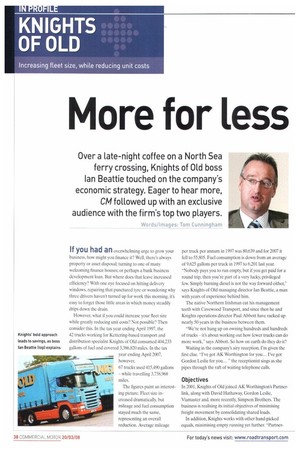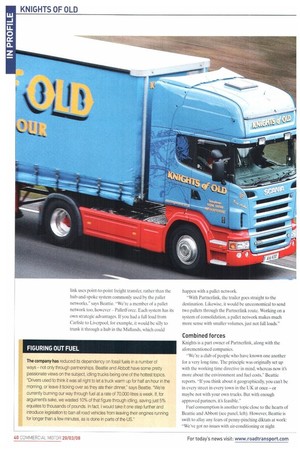More for less
Page 38

Page 40

Page 41

If you've noticed an error in this article please click here to report it so we can fix it.
Over a late-night coffee on a North Sea ferry crossing, Knights of Old boss Ian Beattie touched on the company's economic strategy. Eager to hear more, CM followed up with an exclusive audience with the firm's top two players.
Words/Images: Tom Cunningham
Ifyou had an overwhelming urge to grow your business, how might you finance it? Well, there's always property or asset disposal; turning to one of many welcoming finance houses; or perhaps a bank business development loan. But where does that leave increased efficiency? With one eye focused on hitting delivery windows, repairing that punctured tyre or wondering why three drivers haven't turned up for work this morning, it's easy to forget those little areas in which money steadily drips down the drain.
However, what if you could increase your fleet size while greatly reducing unit costs? Not possible? Then consider this. In the tax year ending April 1997, the 42 trucks working for Kettering-based transport and distribution specialist Knights of Old consumed 404,233 gallons of fuel and covered 3,386,820 miles, In the tax year ending April 2007, however, 67 trucks used 415,490 gallons — while travelling 3,738,968 miles.
The figures paint an interesting picture. Fleet size increased dramatically. but mileage and fuel consumption stayed much the same, representing an overall reduction. Average mileage per truck per annum in 1997 was 80,639 and for 2007 it fell to 55,805. Fuel consumption is down from an average of 9,625 gallons per truck in 1997 to 6,201 last year. "Nobody pays you to run empty, but if you get paid for a round trip, then you're part of a very lucky, privileged few. Simply burning diesel is not the way forward either," says Knights of Old managing director Ian Beattie, a man with years of experience behind him.
The native Northern Irishman cut his management teeth with Cavewood Transport, and since then he and Knights operations director Paul Abbott have racked up nearly 50 years in the business between them.
"We're not hung up on owning hundreds and hundreds of trucks — it's about working out how fewer trucks can do more work," says Abbott. So how on earth do they do it?
Waiting in the company's airy reception, I'm given the first clue. "I've got AK Worthington for you... I've got Gordon Leslie for you... " the receptionist sings as she pipes through the raft of waiting telephone calls.
Objectives
In 2001, Knights of Old joined AK Worthington's Partnerlink, along with David Hathaway, Gordon Leslie, Viamaster and, more recently, Simpson Brothers. The business is realising its initial objectives of minimising freight movement by consolidating shared loads.
In addition, Knights works with other hand-picked equals, minimising empty running yet further. "Partner
link uses point-to-point freight transfer, rather than the hub-and-spoke system commonly used by the pallet networks." says Beattie. -We're a member of a pallet network too, however — PalletForce. Each system has its own strategic advantages. If you had a full load from Carlisle to Liverpool, for example, it would be silly to trunk it through a hub in the Midlands, which could happen with a pallet network.
"With Partnerlink, the trailer goes straight to the destination. Likewise, it would be uneconomical to send two pallets through the Partnerlink route. Working on a system of consolidation, a pallet network makes much more sense with smaller volumes, just not full loads."
Combined forces
Knights is a part owner of Partnerlink, along with the aforementioned companies.
"We're a club of people who have known one another for a very long time. The principle was originally set up with the working time directive in mind, whereas now it's more about the environment and fuel costs." Beattie reports. "If you think about it geographically, you can't be in every street in every town in the UK at once — or maybe not with your own trucks. But with enough approved partners, it's feasible.
Fuel consumption is another topic close to the hearts of Beattie and Abbott (see panel, left). However. Beattie is swift to allay any fears of penny-pinching diktats at work: "We've got no issues with air-conditioning or night heaters, and its true to say were leaving the choice of route to the driver. But you have to realise not everyone makes the right decision: we've got 97 drivers out today; that's 97 people to educate.
The logic undoubtedly makes sense. In another attack on costs, the company recently put its faith in satellite tracking, namely Navman. "We were in a situation where drivers were using their own devices to navigate their way round the countryside which is not, I'm sure you will agree, an ideal solution," says Abbott.
At the time of writing, the new system had been live for only three weeks, but initial indications were favourable. -Some of our partners already operate the same system, so it wasn't a decision taken totally blindfold. The company lives or dies by its decisions those made by drivers and traffic planners alike."
Investment
In addition to rudimentary route calculation and navigation, the pair opted for weight limit and bridge height information. They predict the capital outlay (about £40,000) should be recouped in the first year.
As with many who receive goods from a multitude of sources, the warehousing at Knights relies upon a steady stream of trucks in all shapes and forms. As we observe the queue, another facet of money-wasting is highlighted. "Look at this guy here his air kit is three feet below the top of his trailer," says Beattie. We look at one of Knights' own vehicles leaving the yard and, of course, all is well.
"We had two new R-series Scanias in 2005. One returned a healthy lOmpg, while the other returned 9.5," recalls Abbott. After a little head-scratching and observing the pair parked side by side, the cause became clear. On the underperforming truck, the fixed fifth wheel they had opted for was two bolt holes further back, creating a small but significant four-inch, wind-disrupting gap. With a quick fix, both trucks performed equally well.
Then there's the trucks' spec. You have to get your head round the fact that this is a deadly serious business.
"Everything that comes in here is laser-aligned trucks and trailers," says Abbott. -Knights' spec trailers are built on a 100mm neck, which gives us an overall running height of 4.05m, yielding a 2.5m internal height, which is enough for double-stacked pallets."
Introduced in 2004 (in conjunction with the firm's first Scania R-series). the latest generation of automated gearboxes has also delivered savings. Beattie and Abbott believe the fleet average has been brought up to the tune of impg. They admit being biased towards Scania, which in turn has directed them towards EGR rather than SCR technology But that doesn't mean the door is closed for AdBlue use. Far from it.
Additives
A recent flagship R500 Topline joined the fleet, which at the time meant SCR. But, overall, Abbott sees SCR as an unnecessary addition. "It's extra weight, extra cost and, in our experience, it doesn't improve the fuel efficiency over EGR. If it does, it's marginal not life-changing. I'm sure if our preferred make was Volvo, we'd have convinced ourselves otherwise. But as it happens, our preferred option was and still is Scania. In any case," Abbott points out, "has anyone calculated the carbon footprint of AdBlue production?"
"On a fleet this size, you only have to improve efficiency by half a percent to make a huge gain," says Beattie. "But with a truck or whole fleet in the wrong hands, losing vast sums of money is a surprisingly easy process. When we say every pound is a prisoner, it's an accurate description of how you have to run a business in 2008." •








































































































































































